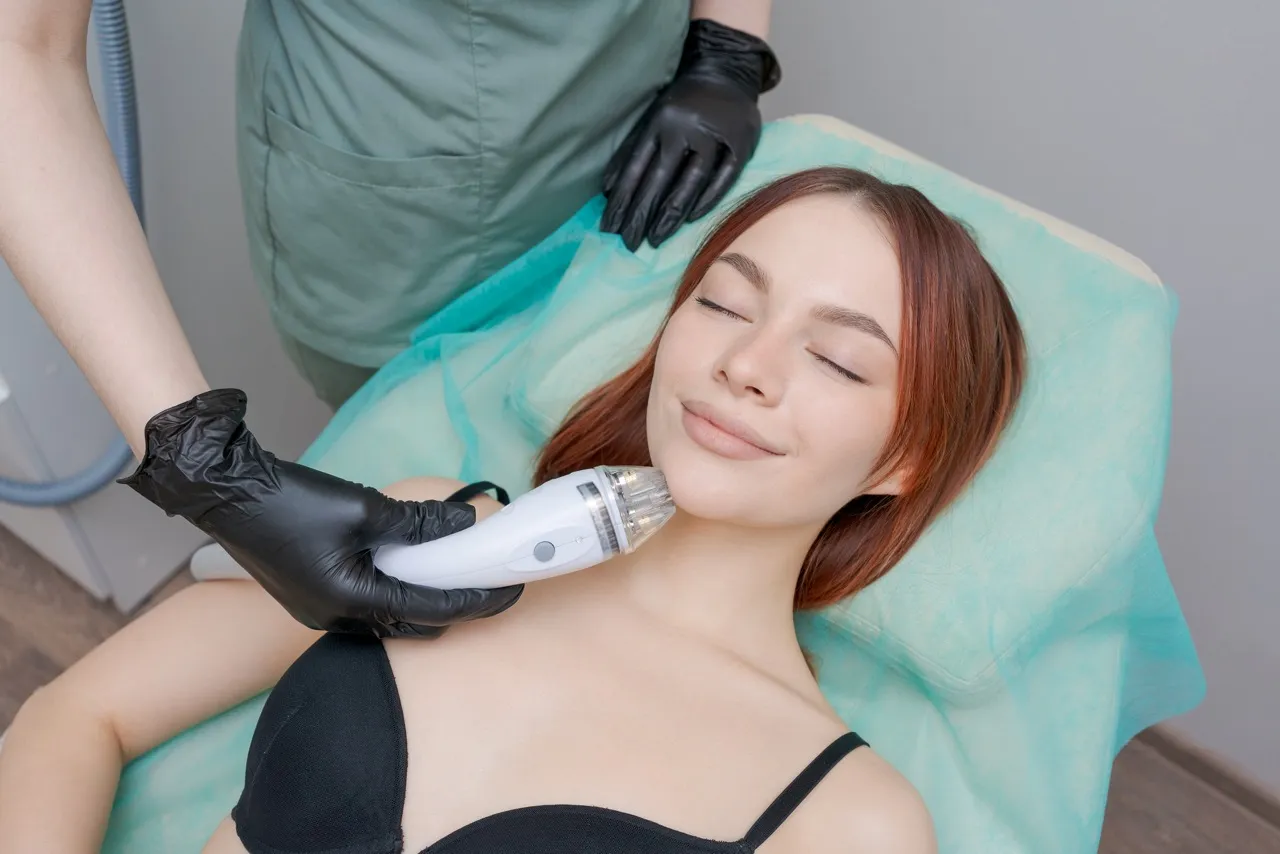
Non-Surgical Face Lift
We use the best and latest Non-Surgical Face Lift techniques to guarantee you get the best results.
Non-Surgical Facelift: The Latest Techniques for a Rejuvenated Look Without Surgery
Non-surgical facelifts have become an increasingly popular option for those seeking to refresh and rejuvenate their appearance without the need for invasive surgery. With advancements in medical aesthetics, it’s possible to achieve noticeable results through a variety of non-invasive or mini

mally invasive treatments that can target sagging skin, fine lines, and wrinkles. For those looking to maintain a youthful appearance without undergoing a traditional surgica
l facelift, a range of options is now available to suit different needs and budgets.
What is a Non-Surgical Facelift?
A non-surgical facelift is a combination of treatments designed to lift, tighten, and smooth the face without requiring invasive surgery or significant downtime. Unlike traditional facelifts, which involve incisions and recovery periods, non-surgical facelifts rely on minimally invasive techniques that provide results gradually and with little to no recovery time. These procedures can address common signs of aging, such as wrinkles, volume loss, and sagging skin, by stimulating collagen production, improving skin texture, and enhancing facial contours.
Benefits of Choosing a Non-Surgical Facelift
Opting for a non-surgical facelift offers several appealing benefits:
- Minimal Downtime: Most treatments have little to no recovery time, allowing patients to resume their normal activities shortly after the procedure.
- Natural-Looking Results: Non-surgical options often provide subtle, natural enhancements that refresh the face without creating a “done” look.
- Lower Cost Compared to Surgery: Non-surgical options are generally more affordable than a full surgical facelift.
- Fewer Risks: Without general anesthesia or major incisions, non-surgical facelifts present fewer risks and complications.
- Customizable: Treatments can be tailored to target specific areas of concern, allowing for a personalized approach to facial rejuvenation.
Popular Non-Surgical Facelift Options
Non-surgical facelift options range from injectables to skin-tightening treatments, each offering unique benefits depending on individual goals. Here are some of the most popular options:
Injectables: Botox and Dermal Fillers
Injectables are a popular choice for those looking to address fine lines, wrinkles, and volume loss.
Botox: Botox injections work by relaxing facial muscles that cause wrinkles, particularly around the forehead, between the eyebrows, and around the eyes. Results typically last three to six months, making it a convenient, short-term solution for reducing dynamic wrinkles.
Dermal Fillers: Fillers, such as hyaluronic acid-based products, add volume to areas like the cheeks, lips, and under the eyes. They can also be used to contour the jawline or fill in deep creases. The effects of fillers can last anywhere from six months to two years, depending on the product used.
Thread Lifts
A thread lift involves the use of dissolvable sutures placed under the skin to lift and tighten areas of the face, such as the cheeks, jawline, and neck. The threads not only provide an immediate lift but also stimulate collagen production over time, enhancing the skin’s firmness and elasticity. Results can last up to a year, and the procedure requires minimal downtime.
Ultherapy and Radiofrequency Skin Tightening
Ultherapy uses focused ultrasound energy to heat the deeper layers of the skin, stimulating collagen production and gradually tightening the skin over time.
- Radiofrequency (RF) Treatments: RF skin tightening works similarly by heating the skin’s deeper layers to encourage collagen production. Treatments like Thermage or Exilis can address loose skin on the face and neck, providing a firmer and more youthful appearance over several months.
These treatments are generally comfortable, with minimal side effects, and are often completed in a single session or as part of a series for optimal results.
Laser Resurfacing Treatments
Laser treatments, such as fractional lasers, target fine lines, wrinkles, and skin texture. By creating controlled micro-injuries in the skin, these treatments stimulate collagen and promote cell turnover. Laser resurfacing is effective for improving overall skin texture, reducing pore size, and achieving a radiant glow. Depending on the laser used, some treatments may require a few days of downtime for optimal healing.
Chemical Peels
Chemical peels are a non-invasive treatment option that can improve skin tone, texture, and clarity by removing the outer layers of skin. Depending on the strength of the peel, they can address fine lines, sun damage, and even pigmentation issues. Chemical peels range from light to deep, with varying levels of downtime, and can be customized to suit individual skin concerns.
Choosing the Right Non-Surgical Facelift Treatment
Selecting the ideal non-surgical facelift depends on factors like skin type, specific aesthetic goals, and desired results. Consulting with a qualified provider, such as a dermatologist or cosmetic surgeon, is essential for developing a personalized treatment plan. Providers can assess areas of concern, discuss available options, and recommend a combination of treatments to achieve natural-looking, rejuvenated results.
What to Expect During and After a Non-Surgical Facelift
The experience of a non-surgical facelift depends on the chosen treatments, but in general, these procedures are brief, often taking between 15 minutes to an hour. Here’s what patients can typically expect:
Procedure Time: Most non-surgical facelift treatments are completed in under an hour, making them convenient for individuals with busy schedules.
Comfort Level: Some treatments may involve mild discomfort, but numbing creams and other techniques are often available to enhance comfort.
Post-Treatment Care: Aftercare instructions may include avoiding sun exposure, refraining from heavy exercise, and following any recommended skincare routines. Most individuals can resume normal activities almost immediately.
Gradual Results: Unlike surgical facelifts, non-surgical options deliver gradual improvements. Injectables often show results within days, while treatments that stimulate collagen, like Ultherapy, can take a few months to reveal full effects.
FAQs about Non-Surgical Facelift Treatments
How long do non-surgical facelift results last?
Results vary by treatment. Botox lasts 3–6 months, fillers up to 2 years, and skin-tightening treatments can last 1–2 years.
Are non-surgical facelifts safe?
Yes, when performed by a qualified provider, these treatments are generally safe with minimal risk of complications.
How many sessions are required for a non-surgical facelift?
Some treatments, like injectables, show immediate results with one session. Others, like RF treatments, may need multiple sessions.
Is there any downtime after a non-surgical facelift?
Most non-surgical options have little to no downtime, allowing patients to return to daily activities shortly after.
Can non-surgical facelifts be combined with other treatments?
Yes, many providers combine treatments like Botox, fillers, and skin-tightening to achieve comprehensive, natural-looking results.
Who is a good candidate for a non-surgical facelift?
Ideal candidates are those looking to address mild to moderate signs of aging without surgery. However, a consultation with a provider is essential to determine suitability.
Conclusion
A non-surgical facelift can be a valuable option for individuals seeking facial rejuvenation without the commitment of surgery. By exploring options like injectables, thread lifts, and advanced skin-tightening treatments, patients can enjoy a refreshed appearance with minimal downtime. As these treatments continue to evolve, they offer safer, more customizable ways to enhance one’s appearance and restore a youthful glow. For those considering a non-surgical facelift, consulting with an experienced provider is the first step toward achieving personalized, natural-looking results.



What are the benefits and risks of a Non-Surgical Face Lift?
Benefits:
- Minimal to no downtime, allowing most individuals to return to their daily activities immediately after treatment.
- Lower risk of complications compared to surgical facelifts.
- Results are often more subtle, making it a good option for those seeking gradual improvements.
- Procedures can be customized to meet the specific needs and concerns of the individual.
Risks:
- Potential for temporary side effects such as redness, swelling, bruising, and tenderness at the treatment sites.
- Rare risks include allergic reactions, infection, and dissatisfaction with the aesthetic results.
- Results are not as dramatic or long-lasting as those achieved with surgical options, requiring regular maintenance sessions.
Start the change and get the most out of your style with Non-Surgical Face Lift operation in Turkey
Make a free consultation with us.
Get Offer Now
Recent Posts
Have Any Question?
Contact Us
- +905431574540
- info@bestclinicinistanbul.com












